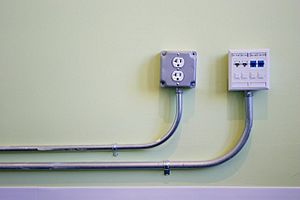Electrical conduit facts for kids

Imagine a strong, protective tube that keeps electrical wires safe. That's what conduit is! It's like a shield for wires, stopping them from getting damaged. You'll often see conduit in places like factories, big offices, or even in your garage or unfinished basement at home. Most homes use a different kind of wiring called NM cable (you might hear it called Romex), but conduit is super important where wires need extra protection. Conduit is usually made of metal, but it can also be made from tough plastic.
Contents
What is Electrical Conduit?
Electrical conduit is a special kind of tubing designed to protect electrical wires and cables. Think of it as a sturdy pathway that guides wires safely from one point to another. This protection is really important because it keeps the wires from being cut, crushed, or exposed to water or chemicals.
Why Do We Use Conduit?
Conduit is used for several important reasons:
- Protection: It shields wires from physical damage, like being stepped on or hit.
- Safety: It helps prevent electrical shocks by keeping wires enclosed. It also reduces fire risks if a wire gets damaged.
- Organization: It keeps many wires neatly bundled together, making them easier to manage.
- Future Changes: It makes it easier to add or remove wires later without tearing down walls.
Where is Conduit Used?
You'll find conduit in many different places:
- Commercial Buildings: Large offices, stores, and schools often use conduit to protect their complex wiring systems.
- Industrial Areas: Factories and warehouses use conduit because their wires need extra protection from heavy machinery and harsh conditions.
- Homes: While most home wiring uses a different method, conduit is common in garages, unfinished basements, and outdoor areas where wires might be exposed to damage or moisture.
Types of Conduit
Conduit comes in different types, each suited for specific jobs:
- Electrical Metallic Tubing (EMT): This is one of the most common types. It's a thin-walled metal tube that's easy to bend and cut. It's often used indoors in dry locations.
- Rigid Metal Conduit (RMC): This is a much thicker and stronger metal tube. It's used where wires need maximum protection, like outdoors or in places with a lot of physical stress.
- Flexible Metal Conduit (FMC): As its name suggests, this type is flexible. It's useful in tight spaces or where equipment might vibrate, allowing the wires to move without breaking.
- Plastic Conduit: Made from PVC (polyvinyl chloride) or other plastics, plastic conduit is lightweight and doesn't rust. It's often used underground or in wet locations.
Images for kids
-
This picture shows electrical conduit risers, looking up inside a fire-resistance rated shaft. You can see it entering the bottom of a firestop. The firestop is made of firestop mortar on top and mineral wool on the bottom. These tubes protect electrical cables from damage.
-
Conduit embedded in a concrete structure. This helps distribute electrical cables throughout this tall apartment building.
-
Electrical conduit and bus duct in a building at the Texaco Nanticoke refinery.
See also
 In Spanish: Conducto eléctrico para niños
In Spanish: Conducto eléctrico para niños






